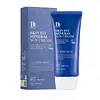What's inside
What's inside
 Key Ingredients
Key Ingredients

 Benefits
Benefits

 Concerns
Concerns

 Ingredients Side-by-side
Ingredients Side-by-side

Water
Skin ConditioningEthylhexyl Methoxycinnamate
UV AbsorberGlycerin
HumectantPropylene Glycol
HumectantCyclopentasiloxane
EmollientPhenylbenzimidazole Sulfonic Acid
UV AbsorberBis-Ethylhexyloxyphenol Methoxyphenyl Triazine
Skin ConditioningDicaprylyl Carbonate
EmollientIsoamyl P-Methoxycinnamate
UV AbsorberPotassium Cetyl Phosphate
EmulsifyingAlcohol
AntimicrobialDimethicone
EmollientButylene Glycol
HumectantGlyceryl Stearate
EmollientTitanium Dioxide
Cosmetic ColorantC14-22 Alcohols
Emulsion StabilisingPolymethyl Methacrylate
Cetearyl Alcohol
EmollientPEG-100 Stearate
Triethanolamine
BufferingSilica
AbrasiveSodium Hydroxide
BufferingDimethicone/Vinyl Dimethicone Crosspolymer
Skin ConditioningC12-20 Alkyl Glucoside
EmulsifyingAluminum Hydroxide
EmollientStearic Acid
CleansingParfum
MaskingCaprylyl Glycol
EmollientPhenoxyethanol
PreservativeAcrylates/C10-30 Alkyl Acrylate Crosspolymer
Emulsion StabilisingAloe Arborescens Leaf Extract
MoisturisingDipotassium Glycyrrhizate
HumectantCarbomer
Emulsion StabilisingXanthan Gum
EmulsifyingLimonene
PerfumingTocopheryl Acetate
AntioxidantDisodium EDTA
Hexyl Cinnamal
PerfumingLinalool
PerfumingBenzyl Salicylate
PerfumingGeraniol
PerfumingBenzyl Alcohol
PerfumingCitronellol
PerfumingBenzyl Benzoate
AntimicrobialCitral
PerfumingWater, Ethylhexyl Methoxycinnamate, Glycerin, Propylene Glycol, Cyclopentasiloxane, Phenylbenzimidazole Sulfonic Acid, Bis-Ethylhexyloxyphenol Methoxyphenyl Triazine, Dicaprylyl Carbonate, Isoamyl P-Methoxycinnamate, Potassium Cetyl Phosphate, Alcohol, Dimethicone, Butylene Glycol, Glyceryl Stearate, Titanium Dioxide, C14-22 Alcohols, Polymethyl Methacrylate, Cetearyl Alcohol, PEG-100 Stearate, Triethanolamine, Silica, Sodium Hydroxide, Dimethicone/Vinyl Dimethicone Crosspolymer, C12-20 Alkyl Glucoside, Aluminum Hydroxide, Stearic Acid, Parfum, Caprylyl Glycol, Phenoxyethanol, Acrylates/C10-30 Alkyl Acrylate Crosspolymer, Aloe Arborescens Leaf Extract, Dipotassium Glycyrrhizate, Carbomer, Xanthan Gum, Limonene, Tocopheryl Acetate, Disodium EDTA, Hexyl Cinnamal, Linalool, Benzyl Salicylate, Geraniol, Benzyl Alcohol, Citronellol, Benzyl Benzoate, Citral
Water
Skin ConditioningZinc Oxide
Cosmetic ColorantCyclohexasiloxane
EmollientButyloctyl Salicylate
Skin ConditioningPropanediol
SolventPropylheptyl Caprylate
EmollientIsododecane
EmollientPolyglyceryl-3 Polydimethylsiloxyethyl Dimethicone
Skin ConditioningDicaprylyl Carbonate
EmollientCaprylyl Methicone
Skin ConditioningNiacinamide
SmoothingDisteardimonium Hectorite
StabilisingHamamelis Virginiana Extract
AntiseborrhoeicMagnesium Sulfate
Methyl Methacrylate Crosspolymer
Vinyl Dimethicone/Methicone Silsesquioxane Crosspolymer
Triethoxycaprylylsilane
1,2-Hexanediol
Skin ConditioningPolyglyceryl-2 Dipolyhydroxystearate
Skin ConditioningLauryl Polyglyceryl-3 Polydimethylsiloxyethyl Dimethicone
Skin ConditioningGlyceryl Caprylate
EmollientCalamine
AbsorbentDipotassium Glycyrrhizate
HumectantMadecassoside
AntioxidantInositol
HumectantPanthenol
Skin ConditioningMadecassic Acid
Skin ConditioningAsiaticoside
AntioxidantAsiatic Acid
Skin ConditioningCaprylyl Glycol
EmollientEthylhexylglycerin
Skin ConditioningAdenosine
Skin ConditioningRosmarinus Officinalis Leaf Oil
MaskingTocopherol
AntioxidantButylene Glycol
HumectantWater, Zinc Oxide, Cyclohexasiloxane, Butyloctyl Salicylate, Propanediol, Propylheptyl Caprylate, Isododecane, Polyglyceryl-3 Polydimethylsiloxyethyl Dimethicone, Dicaprylyl Carbonate, Caprylyl Methicone, Niacinamide, Disteardimonium Hectorite, Hamamelis Virginiana Extract, Magnesium Sulfate, Methyl Methacrylate Crosspolymer, Vinyl Dimethicone/Methicone Silsesquioxane Crosspolymer, Triethoxycaprylylsilane, 1,2-Hexanediol, Polyglyceryl-2 Dipolyhydroxystearate, Lauryl Polyglyceryl-3 Polydimethylsiloxyethyl Dimethicone, Glyceryl Caprylate, Calamine, Dipotassium Glycyrrhizate, Madecassoside, Inositol, Panthenol, Madecassic Acid, Asiaticoside, Asiatic Acid, Caprylyl Glycol, Ethylhexylglycerin, Adenosine, Rosmarinus Officinalis Leaf Oil, Tocopherol, Butylene Glycol
 Reviews
Reviews

Ingredients Explained
These ingredients are found in both products.
Ingredients higher up in an ingredient list are typically present in a larger amount.
Butylene Glycol (or BG) is used within cosmetic products for a few different reasons:
Overall, Butylene Glycol is a safe and well-rounded ingredient that works well with other ingredients.
Though this ingredient works well with most skin types, some people with sensitive skin may experience a reaction such as allergic rashes, closed comedones, or itchiness.
Learn more about Butylene GlycolCaprylyl Glycol is a humectant and emollient, meaning it attracts and preserves moisture.
It is a common ingredient in many products, especially those designed to hydrate skin. The primary benefits are retaining moisture, skin softening, and promoting a healthy skin barrier.
Though Caprylyl Glycol is an alcohol derived from fatty acids, it is not the kind that can dry out skin.
This ingredient is also used as a preservative to extend the life of products. It has slight antimicrobial properties.
Learn more about Caprylyl GlycolDicaprylyl Carbonate comes from carbonic acid and caprylyl alcohol, a fatty alcohol. It is an emollient and gives skin a velvet feel. The sources of Dicaprylyl Carbonate may be synthetic or from animals.
As an emollient, Dicaprylyl Carbonate creates a film on the skin. This film traps moisture in, keeping your skin soft and hydrated.
Dipotassium Glycyrrhizate comes from licorice root.
Extracts of licorice have demonstrated to have antibacterial, anti‐inflammatory, antiviral, antioxidant properties.
One component, glabridin, has extra potent antioxidant and soothing properties. It has also been found to block pigmentation from UVB rays in guinea pigs.
Licorice Root also contains a flavonoid. Flavonoids are a natural substance from in plants. Flavonoids also have antioxidant properties.
Another component, glycyrrhizin, has been found to have anti-inflammatory and antimicrobial benefits. This may make licorice root extract effective at treating acne. However, more research is needed to support this.
Liquiritin is one of the flavone compounds found in licorice. It has been found to help lighten skin by preventing tyrosinase from reacting with tyrosine. When the two react, protein is converted to melanin. Melanin is the substance in your body that gives your features pigmentation.
Licorice root is native to Southern Europe and Asia. It has been used in traditional Chinese medicine to help with respiratory issues.
Learn more about Dipotassium GlycyrrhizateWater. It's the most common cosmetic ingredient of all. You'll usually see it at the top of ingredient lists, meaning that it makes up the largest part of the product.
So why is it so popular? Water most often acts as a solvent - this means that it helps dissolve other ingredients into the formulation.
You'll also recognize water as that liquid we all need to stay alive. If you see this, drink a glass of water. Stay hydrated!
Learn more about Water